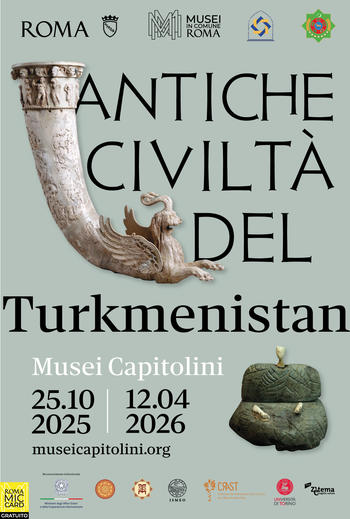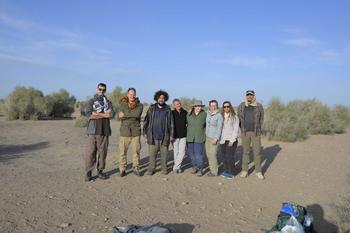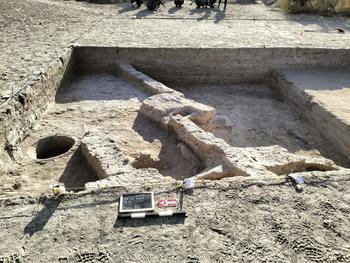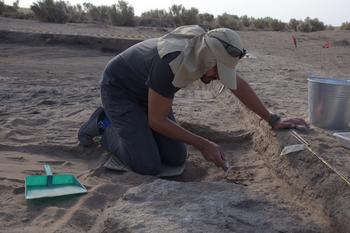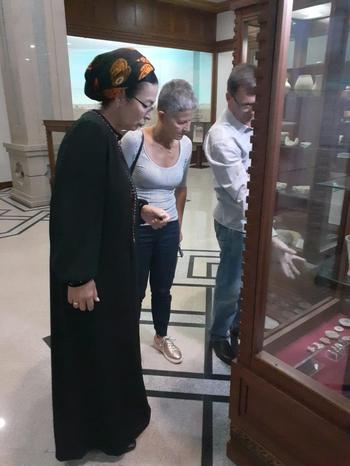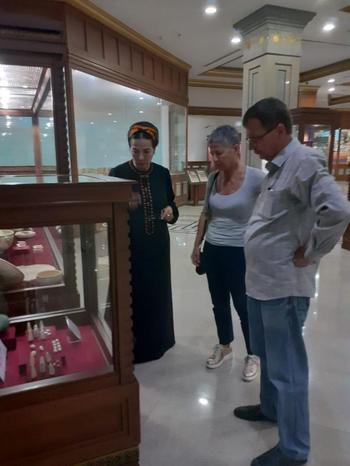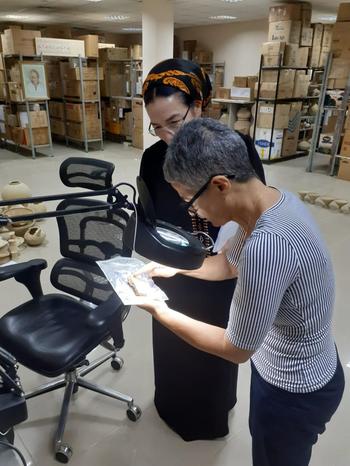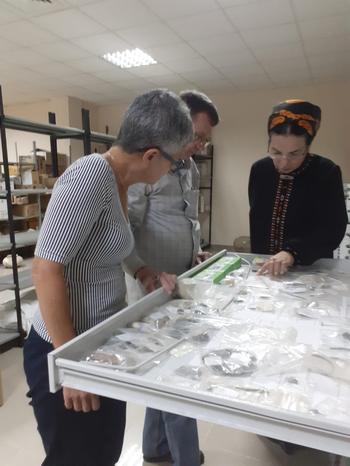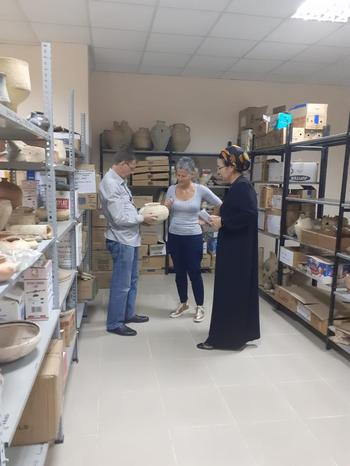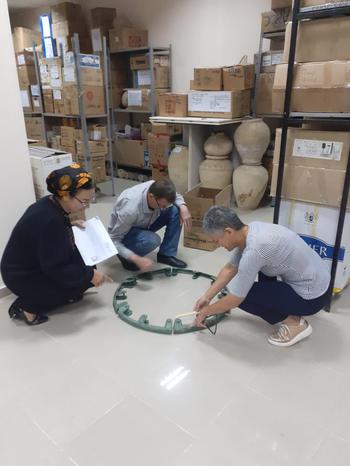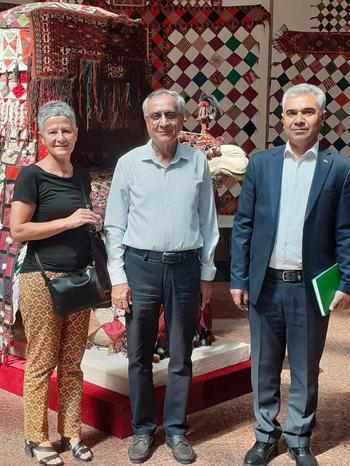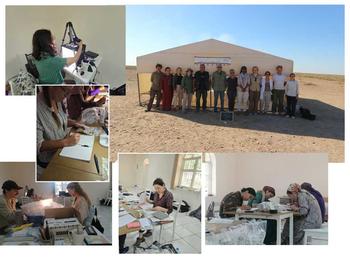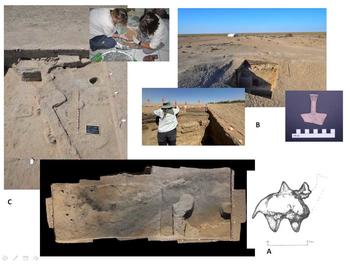TAP - Togolok Archaeological Project (Turkmenistan)
Ancient Civilizations of Turkmenistan - Exhibition
TAP Team 2023 during campaign
Building remains inside Trench 3
Archaeologists at work during compaign 2023
TAP Project, photo 1
Image Credit: Dr. Barbara Cerasetti examining finds in the Museum of Mary (Turkmenistan) together with the Museum's director and the responsable for the archaeological depot of the Museum (photos 1-7).
TAP-Project, photo 2
TAP Project, photo 3
TAP Project, photo 4
TAP Project, photo 5
TAP Project, photo 6
TAP Project, photo 7
TAP Project, photo 8
Image Credit: Dr. Cerasetti with Dr. Meretgeldy Charyev (Director of State Museum of the State Cultural Center of Turkmenistan) and Dr. Mukhamed A. Mamedov (Ministry of Culture of Turkmenistan).
TAP Project, photo 9
Image Credit: The TAP Team at work (2024)
TAP Project, photo 10
Image Credit: Some pictures (2024) from Trench 1 (A), Trench 2 (B), and Trench 3 (C)
Opening on October 25 at the magnificent Capitoline Museums in Rome, the major exhibition Ancient Civilizations of Turkmenistan offers a unique opportunity to admire extraordinary masterpieces never before displayed outside Turkmenistan.
The exhibition brings together a remarkable collection of archaeological artifacts from the protohistoric Margiana (3rd–2nd millennium BCE), located in southeastern Turkmenistan, and from ancient Parthia, particularly the archaeological site of Nisa (2nd century BCE – 1st century CE) in south-central Turkmenistan.
Turkmenistan is one of the richest and most fascinating regions of Central Asia, where, as early as the 3rd millennium BCE, trade routes fostered not only the exchange of goods but also the circulation of ideas, techniques, and knowledge that contributed to the development of both Eastern and Western civilizations.
Curated by Claudio Parisi Presicce, Barbara Cerasetti, Carlo Lippolis, and Mukhametdurdy Mamedov, the exhibition is promoted by Roma Capitale, Department of Culture, and the Sovrintendenza Capitolina ai Beni Culturali, in collaboration with the Ministry of Foreign Affairs and International Cooperation and the Ministry of Culture of Turkmenistan. It is organized by Zètema Progetto Cultura and realized with the support of ISMEO – International Association for Mediterranean and Oriental Studies, CRAST – Centro Ricerche Archeologiche e Scavi di Torino per il Medio Oriente e l’Asia, and the University of Turin.
The exhibition will remain open until April 12, 2026, every day except December 25, from 9:30 a.m. to 7:30 p.m. (on December 24 and 31 from 9:30 a.m. to 2:00 p.m.).
For more information, see also: Antiche civiltà del Turkmenistan | Musei Capitolini (in Italian)
Here is the link to the news on the TAP-Archaeological Project official website: https://togolokarchaelogicalproject.wordpress.com/2024/07/26/a-major-exhibition-on-ancient-turkmenistan-is-currently-in-preparation/
After a long break due to the Covid-19 pandemic, the TAP – Togolok Archaeological Project, directed by Dr Barbara Cerasetti (FU Berlin; ISMEO), has finally started again activities on September 2023 at the Bronze Age settlement of Togolok 1 in collaboration with the Universität Bern, confirming the great opportunity to investigate and promote the extraordinary history and culture of Turkmenistan. The project is sponsored by the DFG ̶ Deutsche Forschungsgemeinschaft, the Italian Ministry for Foreign Affairs and International Cooperation, the ISMEO – The International Association for Mediterranean and Oriental Studies, and the Society for the Exploration of Eurasia. The main partners are ISMEO, the Turkmen Ministry of Culture and the Universität Bern. Other partners and sponsors are the Freie Universität Berlin, the Max Planck Institute of Geoanthropology (Jena), the Deutsches Archäologisches Institut of Berlin, the HERCULES Laboratory (University of Évora), and the University of Salento.
Margiana of the historical times, corresponding to the alluvial fan of the Murghab River in southern Turkmenistan, has often been erroneously considered a marginal area between the Indus Valley to the east and Mesopotamia to the west. Since 1990, the Italian-Turkmen Archaeological Mission has been involved in numerous projects in the region, one of which was the creation of the archaeological map of the alluvial fan (AMMD Project), mainly concerning the study of the settlement pattern during the Bronze and Iron Ages. Over the years, the Italian-Turkmen Archaeological Mission has investigated an area covering over 20,000 square kilometres, leading to the registration of about 2000 sites dating from the Bronze Age to the Islamic period.
Since 2014, the efforts of the mission have been concentrated on the vast Bronze Age site of Togolok 1, one of the main representative settlements of the Bronze Age Margiana. Togolok is a site-cluster composed of more than 30 sites, of which the main mound is Togolok 1. The archaeological team recovered a large amount of data on the latest occupation phases of the GKC proto-urban centre.
-----------
Preliminary results of campaign 2023
During the last campaign, three main trenches have been opened:
- Trench 1 attests the cultural relation of the context to the mobile pastoralist camp occupied by the last inhabitants of the settlement, previously excavated.
- Trench 2 made it possible to analyze again the stratigraphic, structural, and ceramic sequence of the site, and to collect fresh samples for radiocarbon dating from the excavation investigated by V.I. Sarianidi in the ‘80s.
- Trench 3 was opened with the main aim of shortly reaching a robust chronological sequence as an anchor point for the BMAC/GKC culture.
The botanical and faunal investigation testifies one more time to the mixed agro-pastoral economy practised by the local community. A first preliminary study of the metal finds ascertained the presence of a flourishing metallurgical activity, and therefore the existence of local metal workshops. Among the pottery finds, some vessels are produced in mixed techniques: the ceramic is finished on the lathe after initial processing by hand. This process still confirms the occurred integration of mobile pastoralist/sedentary cultures, which characterized the Bronze Age Margiana during the 3rd - 2nd millennia BCE.
Now the research is carried on in the laboratories, awaiting the next campaign in the field. For more information about the project, please refer also to the project website https://togolokarchaelogicalproject.wordpress.com
-----------
The 2024 Fall Season At Togolok 1
The FU – ISMEO joint team, conducted a 4-week field campaign in collaboration with Bern University at the Bronze Age site of Togolok 1 in southern Turkmenistan. On the upper part of the mound, the excavation in Trench 1 completed the understanding of a 3-phase semi-mobile camp, which was composed of a modest house of pakhsa and an open space with a large kiln or fireplace (so far unexcavated). In front of the house, a light shelter was close to an animal penn. Numerous bronze objects, beads, and figurine fragments were found during the excavation.
The goal of reopening Sarianidi’s 1980s step-shaped trench (Trench 2), located to the southeast of Trench 1, was to establish a clear chronological–stratigraphic sequence by way of a well-controlled excavation and to provide fresh samples for radiocarbon dating, as an anchor point for revising the Greater Khorasan Civilization (GKC) timeline. The TAP team carefully (re)excavated the northern section of Sarianidi’s original trench, from the surface to sterile soil. Among the items, three anthropomorphic figurines, one spindle whorl, and several stone tools were uncovered.
Trench 3 was opened in the southwest area of the mound, where the excavation revealed floors, fireplaces, and a large ash-filled pit, along with a clay wall and oven remains in a large courtyard. In one room of the excavated mud-brick/pakhsa structures to the north of the trench, a vessel embedded in the floor, with sterile sandy soil containing animal jawbones was found.
In conclusion, the excavation of Trenches 2 and 3 finally provided sufficient data for a robust chronological sequence for prehistoric Margiana, as well as archaeological material from stratigraphically controlled excavations to prove the intense interaction between the Togolok region and other regions of the Oxus area. Trench 1 finally shed light on the long and complex process of interaction/integration between mobile pastoralists and sedentary farmers in this crucial region during the 3rd-2nd millennia BCE.
We are grateful to the Turkmen Ministry of Culture for their support.
